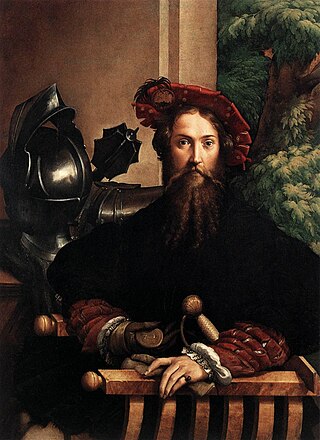Sala or SALA may refer to:

Fontanellato is a small town in the province of Parma, in northern Italy. It lies on the plains of the River Po near the A1 autostrada, about 20 kilometres (12 mi) west of Parma towards Piacenza.

The Rocca Sanvitale, or Sanvitale Castle, is a fortress residence in the centre of the town of Fontanellato, near Parma, northern Italy. Construction of the moated block, accessible through a drawbridge, was begun in the 13th century, mostly completed by the 15th century, with embellishments continuing through to the 18th century. It is prototypical of the urban castle-houses of the turbulent medieval communes of Northern Italy. Until the 1930s it was the home of the descendants of the Count of Sanvitale.

Sala Baganza is a comune (municipality) in the Province of Parma in the Italian region Emilia-Romagna, located about 90 kilometres (56 mi) northwest of Bologna and about 12 kilometres (7 mi) southwest of Parma.

Giuseppe Baldrighi was an Italian painter of the late Baroque (Rococo) and early Neoclassic periods.

Sebastiano Galeotti (1656–1746) was a peripatetic Italian painter of the late-Baroque period, active in Florence, Genoa, Parma, Piacenza, Codogno, Lodi, Cremona, Milan, Vicenza, Bergamo, and Turin.

A rocca is a type of Italian fortified stronghold or fortress, typically located on a hilltop, beneath or on which the inhabitants of a historically clustered village or town might take refuge at times of trouble. Generally under its owners' patronage, the settlement might hope to find prosperity in better times. A rocca might in reality be no grander than a fortified farmhouse. A more extensive rocca would be referred to as a castello.

The Val di Taro is the valley of the Taro river, a tributary of the Po. The valley lies almost entirely in the Province of Parma, in the Emilia-Romagna region of Italy.
Ottavio Farnese was an Italian nobleman. He was an illegitimate son of Ranuccio I Farnese, Duke of Parma and Briseide Ceretoli, who was at that time unmarried; she was the daughter of Ottavio Ceretoli, a captain who had died in Flanders in the following of Alessandro Farnese, Duke of Parma. The couple also had an illegitimate daughter, Isabella.

Portrait of Galeazzo Sanvitale (1524) is a painting of the condottiero Gian Galeazzo Sanvitale by the Italian late Renaissance artist Parmigianino. It is housed in the National Museum of Capodimonte, Naples, Italy.

Gian Galeazzo Sanvitale, also known as Galeazzo I Sanvitale was an Italian condottiero, a member of the noble Sanvitale family.

The Sanvitale conspiracy was a plot to assassinate Ranuccio I Farnese, Duke of Parma and Piacenza, and members of his family at the baptism of his new-born son Alessandro in 1611. The conspiracy may also be referred to in Italian as the congiura dei feudatari, "conspiracy of the feudal lords", or as the congiura del 1611, "conspiracy of 1611".

Giuseppe Alinovi was an Italian painter, mainly painting vedute in a Neoclassical style, often in light watercolors. The Italian composer and court organist Giuseppe Alinovi was his father.

Giovan Battista Borghesi, also called Giovanni Battista or Giambattista was an Italian painter and scenic designer of the Neoclassic period, active mainly in Parma.

Federico Sanvitale was an Italian mathematician and Jesuit that marked a pivot moment for the growth of Brescia's scientific culture.
Sanvitale is an Italian surname. It may refer to:

The Sanvitale Madonna and Child is a 1524 fragment of a lunette fresco by Parmigianino at the Palazzetto Eucherio Sanvitale in Parma. It is heavily influenced by Correggio, particularly quoting his Madonna of the Stairs. It dates to just before Parmigianino set off for Rome in 1525, particularly by comparing it with his other works from that period such as his Diana and Actaeon frescoes at Rocca di Fontanellato. Preparatory drawings for the work survive in the British Museum's Department of Prints and Drawings, the Cabinet des Dessins at the Louvre and a private collection.

Barbara Sanseverino was an Italian noblewoman.

The Rocca Sanvitale or Sanvitale Castle of Sala Baganza is a fortress/palatial residence located on Piazza Gramsci #1, overlooking the small town of Sala Baganza, just southwest of Parma, region of Emilia-Romagna, Italy. It is distinct from the more-visited moated castle of Rocca Sanvitale, Fontanellato.













